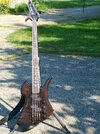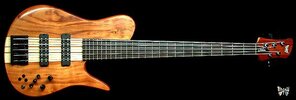Das stimmt so nicht. Schaut mal, die Großmeister von Fodera bieten das sogar explizit als "extended b" headstock an!
Anhang anzeigen 152538
Belege:
Mitarbeiter von Fodera dazu:
A lot of it has to do with the relationship between the transverse and longitudinal vibration of the string. The relatively gentle angle over the head stock doesn't necessarily entirely stop the longitudinal vibration of the string...so the actual length of the string as it vibrates in the longitudinal mode is increased, and hence the frequency of that mode is lower. If that frequency happens to wind up being a multiple of (or a consonant part of the overtone series of) the transverse mode's fundamental, it will have a more synergistic and supportive effect on the overall sound of the string. You can read more about this...which is fact, not theory...at the link below. Bear in mind that in a piano, the strings are sharply cut off where on a bass the strings make a fairly gentle angle over the nut and a B has much, much less tension than a piano string and hence less down bearing.
Seine Quelle:
http://www.speech.kth.se/music/5_lectures/conklin/longitudinal.html




